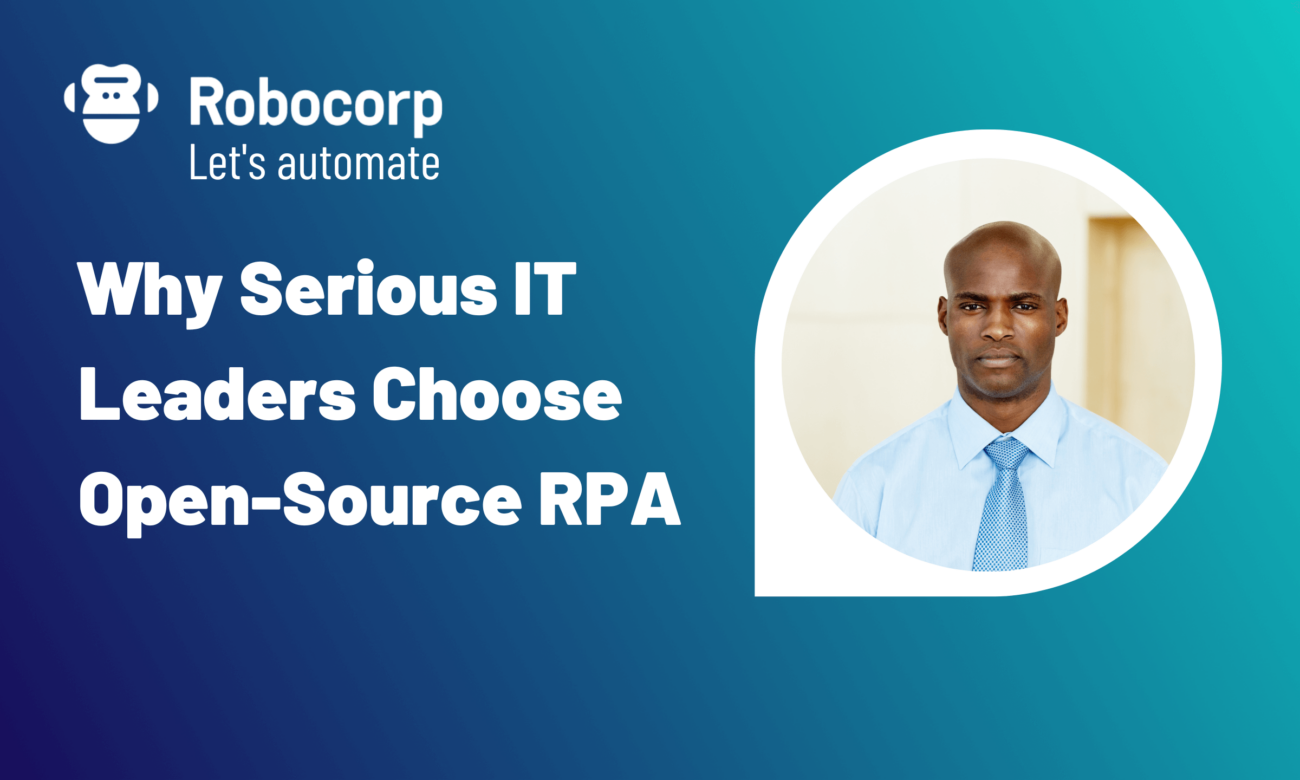Why Serious IT Leaders Choose Open-Source RPA
Lessons Learned from Robocorp Customers

Robotic process automation, or RPA, is a technology that automates repetitive, rule-based digital tasks. It can be used for simple data entry or highly complex back-office processes. A top reason enterprises rely on RPA is that it helps to improve efficiency and accuracy by eliminating human error from mundane tasks. In addition, RPA can free up employees’ time to focus on more value-added activities.
RPA is popular right now, and enterprises are buying in. Gartner estimates worldwide RPA spending to be $2.9B with an annual growth rate of 31%, nearly double the global software market’s average annual growth rate. So this begs the question, why are companies rushing to RPA, especially open-source RPA, to optimize their operations? Let’s take a short walk down memory lane.
Decades of buying enterprise technology.
Enterprises, especially large ones, are complex living things. They have compartmentalized support functions and go-to-market teams. These silos don’t always consult each other on significant software purchases or agree on processing best practices.

- The 1970s & 80s – Mainframes and customized homegrown systems were the norm. Some enterprises still rely on these technologies as their systems of record. The green screens may have been replaced by Java-built GUIs, but critical information is still deposited in their data stores.
- Mid-1990s through Late-2000s – Enterprise resource planning (ERP) platforms became the rage. They promised to simplify and consolidate data access across finance, HR, IT, and customer service departments. Companies spent millions of dollars on software licenses, hosting, and systems integration. These software providers made their solutions sticky – so most enterprises still rely on them for their core data needs.
- 2010s – 2020s – Silicon Valley created a new generation of cloud-based SaaS solutions that was agile, scalable, and generally consumption-based. Tools like Salesforce, Google Workspace (formerly G Suite), Microsoft Office 365, Workday, Freshbooks, and more made it easier for departments to get work done.
Years of fragmented software purchases and disjointed tasks resulted in a complicated matrix of operating models and technologies that need help working together to achieve optimal accuracy and productivity.
Proprietary RPA startups recognized the fractured nature of enterprise technologies. They sought to tie them together to automate as many processes as possible, with citizen developers at the center of these initiatives. Unfortunately, companies realized shortcomings in these RPA solutions and still needed human involvement for complicated processing.
Traditional RPA fell short of customer expectations.
So why isn’t proprietary RPA the magical solution promised? Our customers and partners call out several overarching reasons.

- UI-based citizen developer tools lack specific interfaces and functionality needed to transact business between cloud, ERP, and legacy systems still in use.
- Proprietary robots tend to break frequently, causing downtime, rework, and complicated find / fix routines.
- Lack of control and governance around developer ops and user management.
- Orchestrating bots can be slow and expensive due to restrictive licensing and infrastructure constraints.
Serious IT leaders choose open-source RPA for mission-critical outcomes.
Most of our customers came to Robocorp after using competitor RPA solutions. They needed better and more dependable ways to do business. So they elected to add open-source RPA to their toolbox to gain the required performance and flexibility they need.
By its nature, open-source RPA, including the Python programming language, offers a powerful, flexible and agile way to glue together disparate enterprise applications and transact business – without disrupting core legacy systems or existing RPA workflows.
From simple to complex business use cases, open-source RPA empowers enterprise teams to build, deploy and scale durable automations quickly using a code-native, developer-centric approach.
Building open-source bots.
Open-source offers unrivaled control and stability so robot creators can reduce broken bots, gain new automation possibilities, and build portable bots without vendor lock-in. In addition, it can be integrated with virtually any technology, including other RPA tools, to create powerful and flexible automation solutions – and is free to use without licensing costs or commitments.

- Dev Tool Agnostic – open-source robot frameworks let developers use VS Code (free) or their favorite integrated development environment (IDE) to build complex bots. They’re not locked into proprietary drag-and-drop tools that offer limited modules, functionality, and features.
- Automate Virtually Any Process – open-source technology, by its openness, is highly adaptable to work with customized processes and applications. Built-in data structures, combined with dynamic typing and binding, make it attractive to use as a scripting or glue language to connect existing components.
- Composable and Extensible Libraries – open-source gives developers a composable way to create, reuse, and extend automations through centralized libraries and keywords. This eliminates the need to rebuild functions repeatedly, speeding development and lowering maintenance overhead.
- Reduces Broken Bots – multi-channel automation improves processing accuracy and reduces maintenance by automating deeper into application layers (UI, locators, API, Data) to make automations more flexible and durable.
- Complements Existing RPA Tools – there’s no need to replace current technology that’s working well. Instead, open-source bots complement and extend the functionality and value of prior investments by integrating with virtually any technology to automate end-to-end processes.
- Extends Commercial Applications – developers can add new features and functionality to popular ERP, IDP, chat, and MS Power Apps. This works excellent for pairing assisted and unassisted automations and breathing new life into aging platforms.
- No Vendor Lock-in – open-source robot code is portable. Customers retain IP ownership and are not obligated to remain with a particular vendor for support or orchestration.
Deploying open-source bots.
Deploying open-source bots using GitOps enables better traceability, compliance, and governance than most low-code-base RPA platforms. This approach uses DevOps best practices such as version control, collaboration, compliance, and CI/CD tooling – and applies them to infrastructure automation. It also enables containerization and microservices.

Automation teams can manage their entire infrastructure and application development lifecycle using a unified tool. This allows for greater collaboration and coordination between teams and results in fewer errors and faster problem resolution.
- The Git repository – is the source of truth for the application configuration and code.
- CD pipeline – is responsible for building, testing, and deploying the application.
- Deployment tool – is used to manage the application resources in the target environment.
- Monitoring system – tracks the application performance and provides feedback to the development team.
Orchestrating open-source bots.
Open-source enables developers to securely orchestrate bots for virtually any process –– with exceptional speed and elasticity – with no licensing fees and a consumption-based pricing model.
Depending on the provider, open-source developers can choose cloud, on-premise, or hybrid orchestration options to distribute, monitor, and manage robot workforces, in real-time, from one central command center. Robocorp offers all these options.
- Parallel Processing – work items are broken down into smaller subtasks and distributed simultaneously across multiple computing resources for rapid completion. This minimizes metered computing costs and meets customers’ mission-critical service level agreements (SLAs).
- Scaling – offers the ability to quickly and dynamically scale workloads up/down based on demand, without licensing constraints or infrastructure limitations.
- Consumption-based pricing – no licensing fees and pay only for the computing resources you use.
- Security – features include, but are not limited to, separated workspaces, Secure Vault, SOC 2 Type 2, GDPR, and HIPAA compliance.
- Analytics – dashboards offer the status of all automated processes – including user and bot traceability for governance and compliance – plus metrics to track business value at a glance.
Open-source RPA helped a Fortune 500 manufacturer.

Emerson is a Fortune 500 industrial solutions company and an early adopter of RPA. They chose a proprietary RPA provider years ago to automate many core processes, including finance operations, complex order management, and supply chain processes with tight SLAs. Unfortunately, they struggled with inflexible architectures and infrastructure constraints that compromised their ability to meet mission-critical business processing SLAs.
Emerson surveyed the RPA landscape for traditional and open-source options. With a robust Python-based framework for building bots and the ability to scale automation up and down and accelerate speeds with parallel processing, the company chose open-source RPA.
As a result, Emerson is 100% SLA compliant; they increased speeds by 72% and reduced infrastructure by 75%. In addition, their stakeholders are happier and have virtually eliminated rework.
Get in touch to learn more about open-source RPA.
Click here to talk to a pro today and learn how open-source RPA can help transform your organization’s mission-critical business processes.
